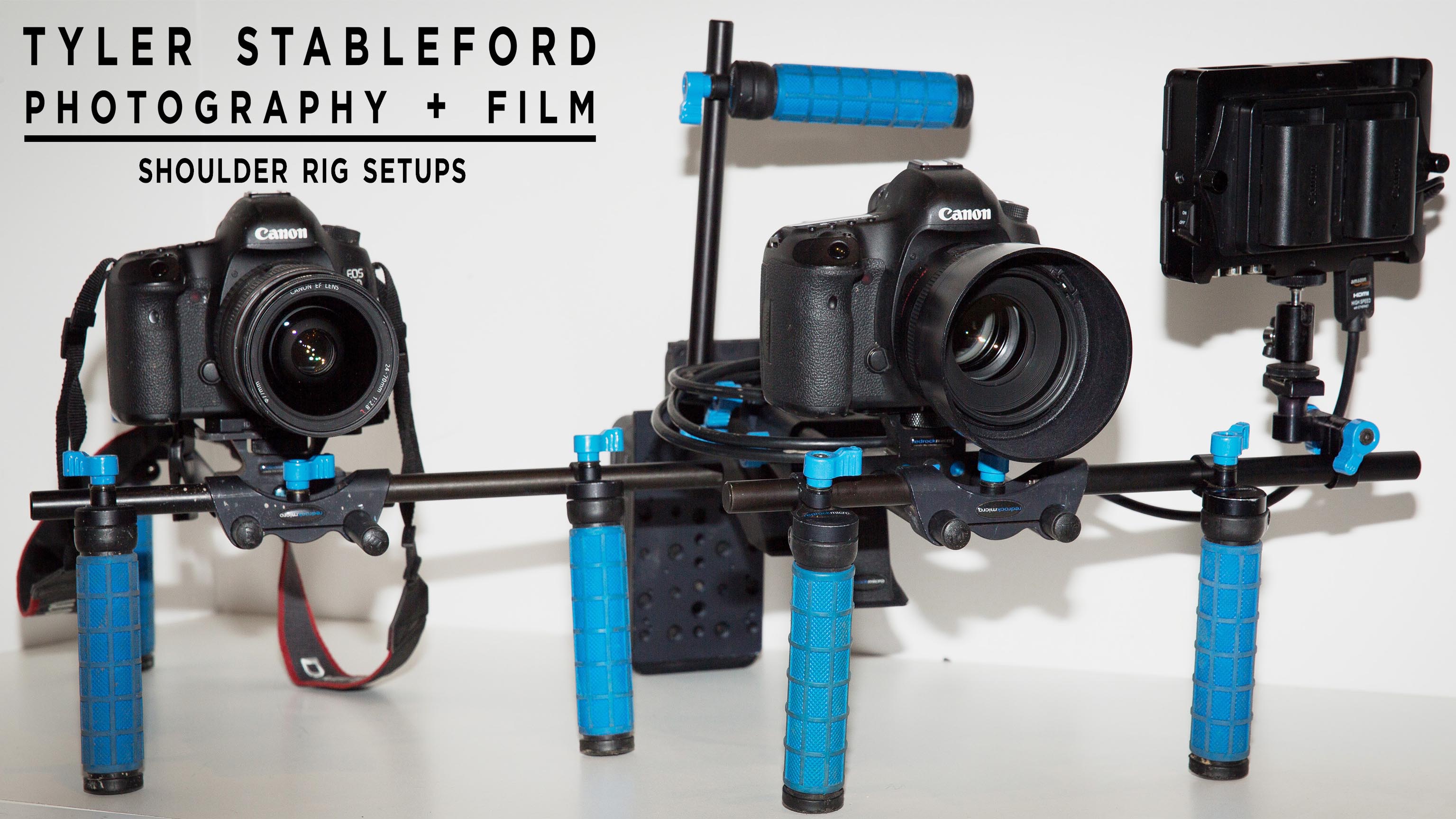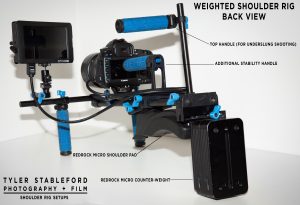
Alright, Ben here again. Now that things have slowed down around here (gotta love Summer, it’s easy to stay busy!), I’m going to continue a look into the shoulder rig setups we like to employ here at Stableford Studios.
Before, we went over the Monopod rig that we love to use for light and fast setups. We’re going to move up a bit footprint wise with our next setup: the shoulder rig. Shoulder rigs can do a wide variety of things for the look of the footage. They can be used to stabilize and function with the cameraman as a more mobile tripod system; they can work for a more polished handheld “floating” camera look; and they can even function for panning or tracking shots depending on the cameraman’s ability to move smoothly with the rig system in place on the shoulder. We work with Redrock Micro’s rig system a lot to create our shoulder rigs. I’m going to highlight two different style of shoulder rigs, both of which we use, depending on our needs.
First up is our very basic shoulder rig. This guys is made up of only 5 total Redrock pieces. We’ve used this rig all over the place. From shooting on oil rigs, to tracking ice climbers as they approach their objective on our short film Shattered. This is the most basic, yet stable shoulder rig system we’ve found. Combined with the Zacuto Z-finder, we’ve eliminated the need for an external monitor and are able to get the camera close to the body, an important factor in maintaining stability with the rig. With both hands on the front handles and the back handle hooked over the shoulder, we’re able to push against our shoulder with the front handles and allow the rig to move with our body. The tension created by the rig helps maintain stability and smoother motion. Mostly, with this system the simplicity is a major part of the appeal. This system is made up of only 5 Redrock Micro pieces. When broken down, the parts can fit in the crevices of just about any bag we’re traveling with and it weighs next to nothing. On our recent trip to Ethiopia, we had two of these shoulder rig systems that fit with the tripod in its protective bag. It was an easy toss-in that gave us even more shooting flexibility. In a place as far from home as eastern Africa, we’ll take it!
While the light shoulder rig system is great, the best part of these Redrock micro systems is how quick and easy it is to build out these shoulder rigs to make them both more robust, but more importantly, more useful. This is a short behind the scenes video showing Tyler using our weighted shoulder rig for our Snowmass Tourism work last winter.
This larger, more complex rig has its own set of advantages. The biggest difference is the addition of the Small HD monitor, the shoulder pad, and the back counter-weight. This type of shoulder rig is used for all-day shooting and when travel weight is less of an issue. The back counter-weight performs a variety of functions. While replacing the back handle “hook” to help control the movement of the rig, the weight itself actually helps the rig remain comfortable over a long day. With the addition of a monitor, batteries, plus the camera and lenses, the weight of the rig can be forward-heavy toward the hand grips; the shoulder pad and weight helps shift the rig’s weight to where you want it, right squarely on the shoulder.

Adding the Small HD DP6 monitor allows helps in a number of ways. In addition to making it easier to frame up shots with the larger monitor screen, the external monitor allows us to pull focus easier (made even easier with the DP6’s focus assist and peaking options) and when shooting run and gun, finding focus is one of the biggest challenges we face. The DP6 also has a battery plate that works with the Canon LP-E6 batteries, the same as our 5D Mark III camera bodies run off of. This allows us to carry only one battery type with us on set, simplifying the packing and on set process. With the addition of the monitor, an HDMI cable from the camera to the monitor is necessary. Cable management then becomes a factor and for that you’ll notice the handle added on the rig works behind the camera as a cable wrap holder, keeping the cable out of the shooters way. This handle also creates another point where the shooter can stabilize the camera from. Holding onto this handle and pressing down against the shoulder can allow the shooter to pull focus with their other hand. Because the rig is balanced over the shoulder, pressing the rig down onto the shoulder still maintains stability of the rig even without any hands gripping the front handles. The additional top handle also allows the option of low angle shooting with the rig (as seen in the Snowmass video). This turns the shoulder rig into a functional, pseudo-underslung rig, opening up low angle shots, particularly helpful when shooting boot product videos for clients like Timberland or Ariat.
These are just two of the infinite ways a shoulder rig can be configured. One of the best aspects of these rigs is the flexibility they give you both before you leave your studio and once you are on set.
